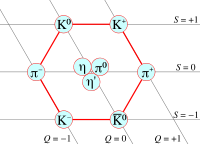Mesons

Mesons of spin 0 form a
|
|
| Composition | Composite—Quarks and antiquarks |
|---|---|
| Statistics | Bosonic |
| Interactions | Strong, Weak, Electromagnetic and Gravity |
| Theorized | Hideki Yukawa (1935) |
| Discovered | 1947 |
| Types | ~140 (List) |
| Mass | From 134.9 MeV/c2 ( π0 ) to 9.460 GeV/c2 ( ϒ ) |
| Electric charge | −1 e, 0 e, +1 e |
| Spin | 0, 1 |
In particle physics, mesons (/ˈmiːzɒnz/ or /ˈmɛzɒnz/) are hadronic subatomic particles composed of one quark and one antiquark, bound together by the strong interaction. Because mesons are composed of quark sub-particles, they have a physical size, with a diameter of roughly one fermi, which is about 2⁄3 the size of a proton or neutron. All mesons are unstable, with the longest-lived lasting for only a few hundredths of a microsecond. Charged mesons decay (sometimes through mediating particles) to form electrons and neutrinos. Uncharged mesons may decay to photons. Both of these decays imply that color is no longer a property of the byproducts.
Outside of the nucleus, mesons appear in nature only as short-lived products of very high-energy collisions between particles made of quarks, such as cosmic rays (high energy protons and neutrons) and ordinary matter. Mesons are also frequently produced artificially in high-energy particle accelerators in the collisions of protons, anti-protons, or other particles.
...
Wikipedia
